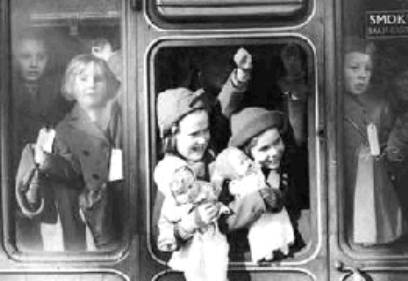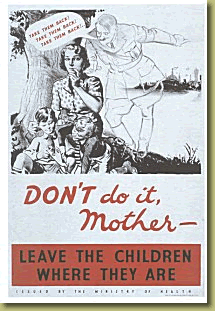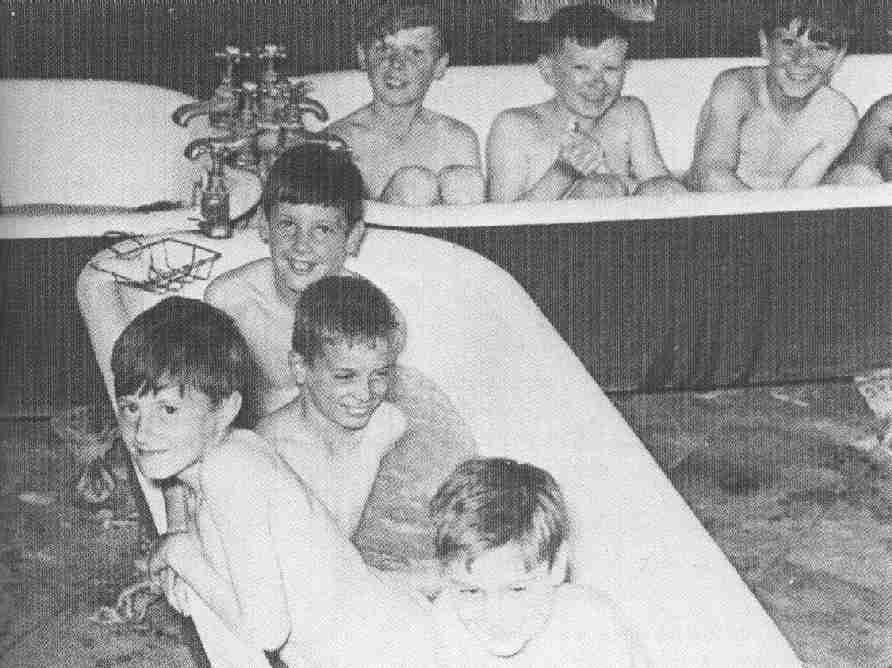|
Except
for a small number the children were filthy and in this
district we have never seen so many verminous children lacking
any knowledge of clean and hygienic habits.
from
an interview with a host family
verminous:
having lice and fleas.
|
Links
Snaith
Primary site - excellent &
easy
YouTube and other movies
BBC movie-animation
 Film clips
Film clips
BBCi
Children of WWII site - simple
The
'HistoryLearning' site - basic
info
The
'BattleofBritain' on evacuations
The
BBCi site on evacuation (esp. the audio-memories)
- fab!
The
Bristol evacuees
The
govt's Learning Curve site
Evacuees'
memories (eye-opening)
Blackpool memories
 Chesham at War: evacuation
Chesham at War: evacuation
An
extract from Norman Longmate's fantastic book: How We Lived
Then
|
|
The
government knew that cities would be bombed, and
thought that gas would be used. A million coffins were
prepared.
It was feared that many child casualties would
affect morale, so pressure was put on parents to send
the children away to the safety of the countryside.
Families
gathered at railway stations.
A label was tied to the children giving their
destination.
The evacuations began on 1st September 1939.
Some parents refused to allow their children to
leave, but amazing numbers sent them away.
Over one million evacuees left London by train.
School
children travelled with their teachers.
Children under five went with their mothers.
Pregnant women were also evacuated
For many children the journey was exciting,
they had never seen the country before. It was the
first time they had seen farm animals.
For many others it was the first time they had
been away from home and they were very distressed.

|

Source A
Government propaganda put immense pressure on
parents to send their children to the ‘safety’ of
the countryside.
In this poster, who is the ghostly figure
whispering ‘Take them back’?
Source
B
Evacuees on a
train out of London, September 1939.
All photographs like this were vetted by the
government before they were released.
|
Source
C
A
teacher remembers being evacuated
with children from her school
All
you could hear was the feet of the children and a kind of
murmur, because the children were too afraid to talk.
Mothers weren't allowed with us, but they came
along behind.
When we got to the station the train was ready.
We hadn't the slightest idea where we were going and
we put the children on the train and the gates closed
behind us. The mothers pressed against the iron gates
calling, 'Good-bye darling'.
from an
interview in 1988 with a teacher.
|
|
Many
evacuees felt homesick.
Strangers chose them and took them to live in
their homes.
They went to the local school and had to make
new friends. Some
ended up with brutal or dirty carers. The country was different to city life.
Some never settled down in their new homes.
Others – such as the comedian Kenneth
Williams – were happier with their new families than
they had been at home.
Very young children sometimes forgot their real
parents.

|
Source D
Evacuees
enjoying a bath – again, a photo published with government
permission.
This picture was published in London, where the
children’s mothers lived.
|
Country
people found the city children hard to cope with.
They were horrified by their ignorance – for
instance, many were amazed to find out that milk came
from a cow.
Many evacuees were poor – they had never worn
underclothes, eaten food from a table or slept in a
bed.
Some were filthy and naughty. Many wet the bed.
Source
E
The
mother of a host family looks back
The
children went round the house urinating on the
walls.
Although we had two toilets they never used
them.
Although we told the children and their
mother off about this filthy habit they took no
notice and our house stank to high heaven.
from
an interview in 1988 with the mother of a host
family
|
Source
F
An
evacuee looks back
How
I wish the common view of evacuees could be changed.
We were not all raised on a diet of fish and
chips eaten from newspaper, and many of us were
quite familiar with the origins of milk.
It is just as upsetting for a clean and
well-educated child to find itself in a grubby
semi-slum as the other way round.
from
an interview in 1988 with someone who was an evacuee
in 1939
|
Source
G
An
extract from a novel about evacuees
Miss
Evans looked down at their feet.
"Better change into your slippers before
I take you to your bedroom."
"We haven't any," Carrie said.
She meant to explain that there hadn't been
room in their cases for their slippers, but before
she could speak Miss Evans turned bright red and
said quickly, "Oh, I'm sorry, how silly of me,
why should you have slippers?
Never mind as long as you're careful and keep
to the middle of the stair carpet where it's covered
with a cloth."
Her brother Nick whispered, "She thinks
we're poor children, too poor to have
slippers," and they giggled.
Nina Bawden, Carne's War (1973)
A novel for children written by someone who had been an
evacuee.
|
Did
You Know?
The
immediate reaction of families, faced with a wild,
filthy urchin, was to blame the parents.
In time, however, they realised that poverty,
rather than parenting, was to blame.
For many middle-class people, it was the first
time they had seen poverty at first hand. In this way, evacuation was one factor which led people to
demand a Welfare State after the war.
|
There
was no bombing between September and Christmas so many
parents took their children home again. Some children were evacuated again the next year and some
stayed in the country for the whole of the war.
Source H
Relations
between evacuees and host families
Many
children, parents and teachers were evacuated when war
was declared. The evacuees were received at reception
centres and then placed with local families.
Arrangements, however, did not always go
smoothly. Unfortunately many evacuees could not settle
in the countryside. The country people were shocked at
the obvious poverty and deprivation of the town
children, not to mention their bad manners.
There were reports of children 'fouling'
gardens, hair crawling with lice, and bed wetting.
D Taylor, Mastering Economic & Social History
(1988)
David Taylor is a modern historian.
|
Extra:
1. Is there any
difference between Source A and Source B?
2. Look
at sources B and C.
Were evacuees excited at the idea of going
away?
3. Which
is more useful to an historian, Source B or Source C?
4.
Sources
E and F are interviews with people involved in
evacuation.
Why are they so different?
5. Source
G is from a children’s novel.
Is it therefore useless to historians?
|
|
|